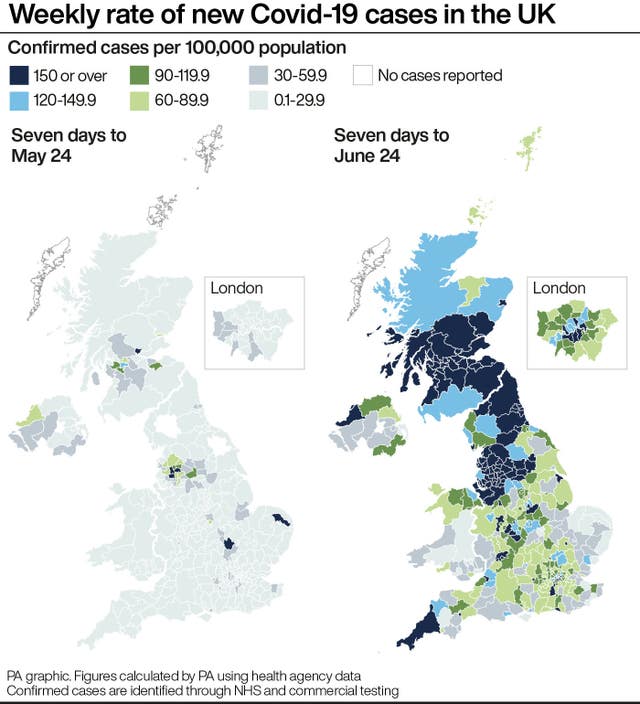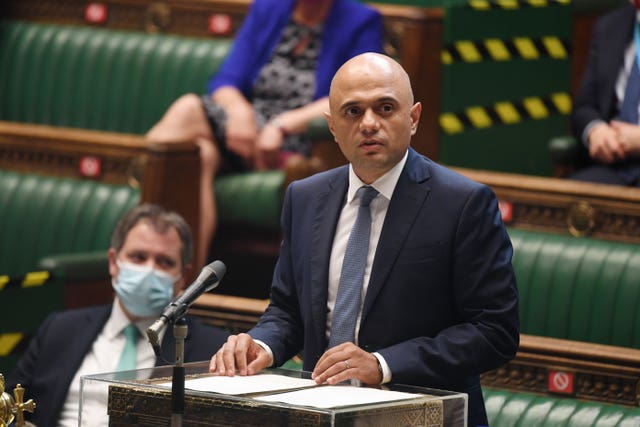Pupil absence in schools due to Covid hits a new record high
The Department for Education has confirmed that school isolation rules in England could be brought to an end this autumn.

Pupil absence in schools due to Covid has hit a new record high since classes went back in March, figures show.
Data from the Department for Education, covering England, shows that around one in 20 (5.1%) state school pupils did not attend class for Covid-19-related reasons on June 24, up from 3.3% on June 17 and 1.2% on June 10.
Around 279,000 children were self-isolating due to a possible contact with a Covid-19 case, a further 24,000 pupils had a suspected case of coronavirus and 15,000 had a confirmed case.

It came after the Department for Education (DfE) confirmed that school isolation rules in England could be brought to an end this autumn.
There are growing concerns about the rising number of children who have to quarantine because they are the contacts of confirmed cases.
Current rules state that children have to self-isolate for 10 days if another pupil in their bubble tests positive for coronavirus.
The DfE said ministers have written to secondary schools asking them to prepare to potentially replace isolation rules with regular testing.
A spokesman said: “We are provisionally asking secondary schools and colleges to prepare to offer on-site testing when students return for the new academic year, so that schools are ready in case it is needed to keep as many children as possible in face-to-face education.
“We will provide further details about the approach to protective measures and test and trace in education from September in due course.”
On Monday, Health Secretary Sajid Javid said he has asked for “fresh advice” on the issue, adding that the policy is “having a huge knock-on impact” on children’s education.

Meanwhile, schools minister Nick Gibb said the Government is carrying out a review into using testing to end self-isolation for school pupils in bubbles.
“We are conducting trials of daily contact testing as a possible alternative to self-isolation,” he told Sky News, adding that a final decision will be taken before July 19.
“What matters also is that we keep the school safe and, if you go around our schools, you will see a raft of measures to reduce the infection rates within schools.
“There’s extra hygiene, there’s staggered breaks, we keep children in bubbles, and there’s extra ventilation in classrooms to minimise the risk of transmission.”
Scientists have broadly backed any change to the rules, with Professor Adam Finn, from the Joint Committee on Vaccination and Immunisation (JCVI), saying children “don’t get ill very much when they get this infection so the harm that’s done to them by closing schools or by excluding them from schools far exceeds any harm they get from the virus itself”.
He told LBC radio there needs to be a “balanced response”, adding that “anything that can be done to minimise the disruption to children’s education is a good thing as far as I’m concerned”.
Professor Russell Viner, a member of Scientific Advisory Group for Emergencies (Sage), said schools had played an important role but the system now appears “to be having very significant unintended consequences in terms of loss of education and social isolation, with impacts upon children’s mental health”.
He added: “It is now time to undertake an evidence-based reassessment of our system of controls in schools for September.
“We will then have a nearly fully vaccinated adult population – which undoubtedly changes the balance of risks for the controls which we place on our children and young people in schools.
“Children and young people will be the only substantial unvaccinated segment of the population – and we must be careful that we don’t apply unnecessary controls to their lives in schools when vaccinated adults have more freedom.”
He said he supported lateral flow testing but given that we should have more “spare” PCR test capacity owing to people being vaccinated, more PCR testing could be dedicated to schools “potentially allowing more rapid release of negative contacts from isolation”.
Fellow Sage member Professor John Edmunds said: “The prevalence of infection in schoolchildren attending school has been lower than the prevalence of infection in the same age groups in the community, suggesting that isolation of ‘bubbles’ has worked at reducing infection in schools.
“It is, of course, very disruptive, particularly as prevalence increases, as is occurring at the moment.
“Vaccination of schoolchildren would be a far better method for reducing transmission in school without disruption, but we need to be sure that the vaccines are safe enough to use in children before considering this option.”
Geoff Barton, general secretary of the Association of School and College Leaders, said: “Identifying close contacts and asking them to self-isolate is an incredibly time-consuming process for schools and colleges, and involves yet more educational disruption for the young people concerned.
“It is clear that a different approach is needed in the autumn term but what we have heard so far from the Government amounts to no more than vague aspirations and there is still no robust and coherent plan in place.”
There are similar moves to address the issue in Wales, where education minister Jeremy Miles suggested on Monday classroom bubbles would be scrapped after the summer after he told a press conference a new national framework for schools would look at removing the staggering of the school day for learners.
And Scotland has seen a sharp rise in pupils who are absent from school during June, with the number almost quadrupling since the start of the month.
The total number of pupils off each day rose from 11,030 (9.8% of all pupils) on June 1 to 42,453 (24.4%) on June 24.
It came as the new Children’s Commissioner for England said bubble arrangements and self-isolation for school pupils should end soon.
Dame Rachel de Souza said there is an urgent need for children to get back to normal as lockdown restrictions have been a “real trauma” for many young people.
In an interview with the Daily Telegraph, Dame Rachel said children needed to get back to normal.
“The experience of lockdown has been a real trauma, and I think we shouldn’t underestimate it,” she said.
“Children are really troubled, and it’s right across the board.”
Dame Rachel said young people, who have seen their normal childhood disrupted in order to protect older people, are now struggling with their mental health.





